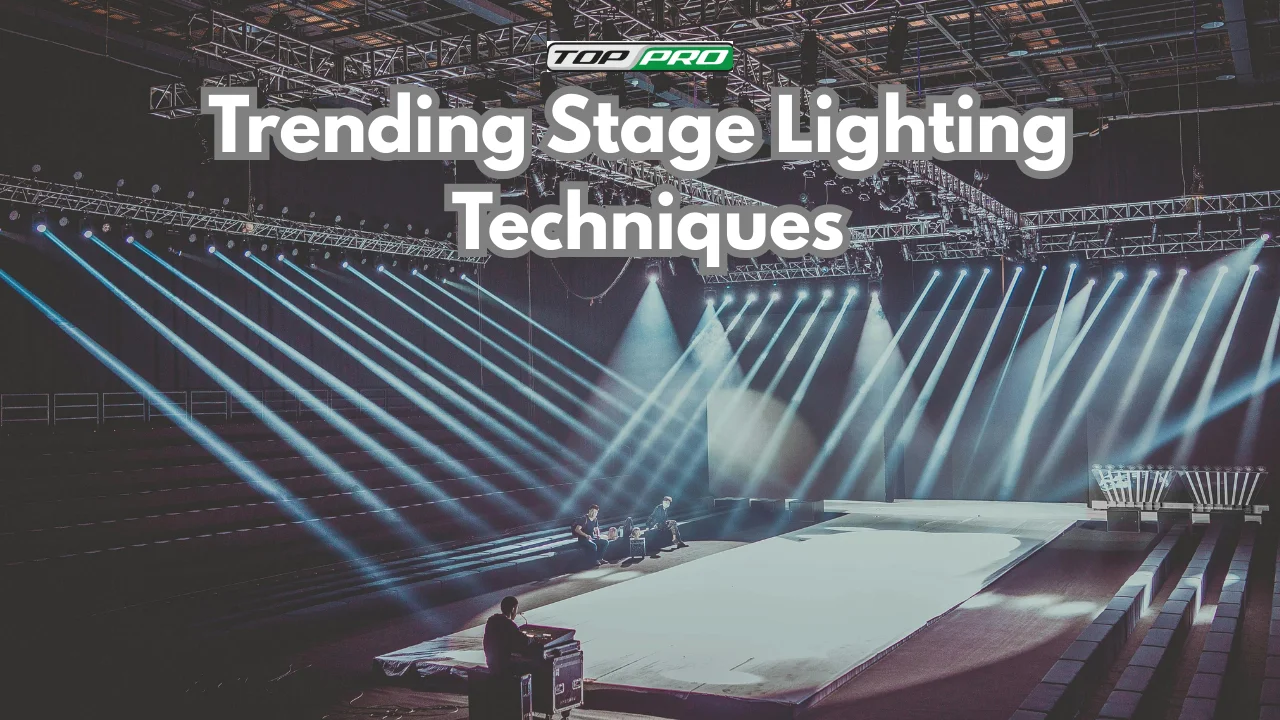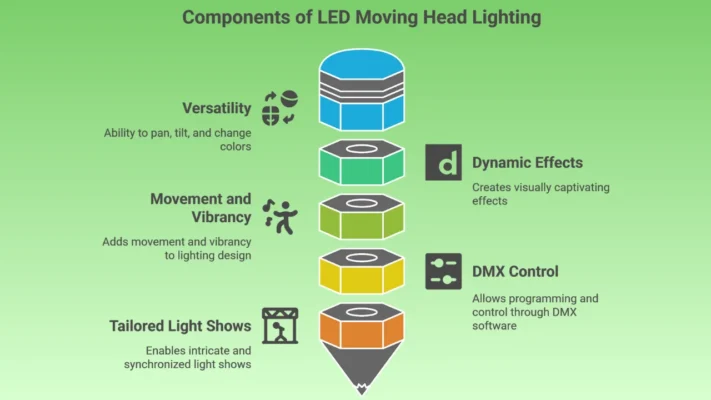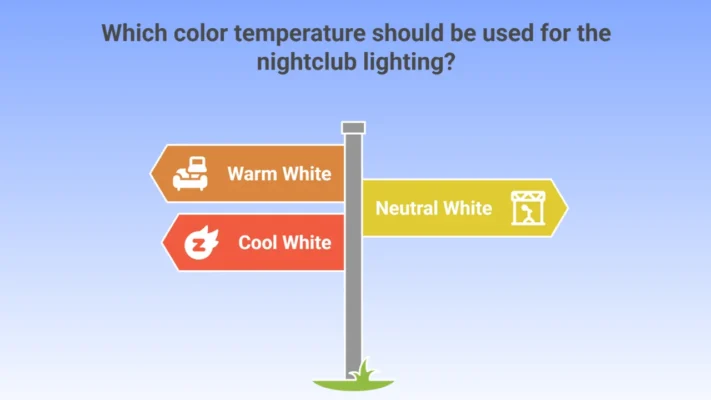Trending Stage Lighting Techniques for DJs and Nightclubs

In Dubai’s world-class nightlife scene, the sound may set the rhythm—but the lighting creates the magic. In 2025, stage lighting for DJs and nightclubs is no longer just decoration—it’s the pulse that drives the crowd, shapes the atmosphere, and makes every beat unforgettable. Weak lighting can flatten even the best DJ set, while the right nightclub lighting design transforms an average night into a legendary experience.
This guide dives into cutting-edge stage lighting techniques, the gear dominating 2025’s club scene, and how to sync your lights and music for an immersive Dubai-worthy spectacle.
Stage Lighting Techniques the nightclub environment in several ways:
- Atmosphere: Different lighting colors and intensities can evoke various emotions and set the overall tone of the venue. For instance, warm colors like red and yellow create an intimate and cozy atmosphere, while cool colors like blue and green evoke a more relaxed and chill vibe.
- Focus: By directing the audience’s attention to specific areas, lighting helps highlight critical moments in a DJ set or a performance, ensuring the crowd is engaged and energized.
- Dynamic Effects: Moving lights, strobes, and lasers can create dynamic visual effects that complement the rhythm and energy of the music, enhancing the audience’s sensory experience.
Essential Lighting Fixtures and Equipment
LED moving heads are a staple in modern stage lighting setups. These versatile fixtures can pan, tilt, and change colors, creating dynamic and visually captivating effects. They are ideal for adding movement and vibrancy to a lighting design. The ability to program and control them through DMX software allows intricate and synchronized light shows tailored to any music genre or performance style.

Laser Lights
Laser lights produce precision beams that can create intricate patterns and designs. They are perfect for adding a futuristic, high-energy element to a nightclub’s lighting setup. Lasers can draw the crowd’s attention, create mesmerizing effects on fog or haze, and synchronize with the beat of the music for an immersive experience.
Strobe Lights
Strobe lights are known for their rapid flashing effects, which can add a sense of urgency and excitement to the dance floor. They are particularly effective during high-energy moments in a DJ set, creating a thrilling and intense atmosphere. When used in moderation, strobes can amplify the crowd’s energy and enhance the overall visual impact of the lighting design.
LED Strip Lights
LED strip lights are versatile and can outline a nightclub’s stages, DJ booths, and other architectural elements. They offer various colors and effects, from smooth transitions to chasing patterns. LED strips are also energy-efficient and can be easily integrated into multiple parts of the venue to add depth and dimension to the lighting design.
Smoke and Fog Machines
Smoke and fog machines are essential tools for enhancing the visibility of light beams and creating a more immersive atmosphere. By adding a layer of haze to the air, these machines make the light beams more pronounced and dramatic. They are especially effective with laser lights and moving heads, adding depth and texture to the lighting effects.
Advanced Lighting Techniques
Synchronized Light Shows
Using DMX controllers and software, DJs and lighting technicians can create synchronized light shows perfectly timed with the music. This involves programming lighting cues and effects corresponding to specific moments in a DJ set, such as drops, builds, and transitions. Synchronized light shows enhance the overall experience by creating a seamless integration between the audio and visual elements.
Sound-to-Light Integration
Sound-to-light integration is a technique that syncs lighting effects with the beat and dynamics of the music. By using audio triggers and sensors, lighting systems can automatically respond to changes in the music, creating a dynamic and responsive light show. This technique is particularly effective for live performances and DJ sets, ensuring the lighting is always harmonious with the music.
3D Mapping
To create immersive and interactive environments, 3D mapping involves projecting light and visuals onto three-dimensional surfaces, such as walls, ceilings, and stage props. This technique can transform ordinary spaces into visually stunning landscapes, adding a new dimension to the nightclub experience. 3D mapping is often used to create themed environments or enhance a DJ set’s visual storytelling.
Kinetic Lighting
Kinetic lighting involves using moving fixtures and motorized systems to add motion and movement to the light show. This can include moving trusses, rotating mirrors, and automated light fixtures that move in sync with the music. Kinetic lighting adds a dynamic and captivating element to the lighting design, creating a sense of motion and energy that enhances the overall experience.
Pixel Mapping
Pixel mapping is a technique that involves controlling individual LEDs to create intricate patterns and visual effects. This allows for highly detailed and customizable light shows that can be tailored to the specific music and atmosphere of the nightclub. Pixel mapping can create stunning visual displays on LED walls, floors, and ceilings, adding a high-tech and futuristic element to the lighting design.
Color Theory and Lighting
Understanding Color Temperature
Colour temperature refers to the warmth or coolness of a light source and is measured in Kelvin (K). Different colour temperatures can evoke different moods and atmospheres:
- Warm White (2700K–3000K): Cozy, lounge-style.
- Neutral White (3500K–4100K): Balanced, general dance floor.
- Cool White (5000K–6500K): Crisp, futuristic vibe.
Popular Color Schemes and Their Psychological Effects
Colour plays a significant role in the psychological impact of lighting. Here are some popular colour schemes and their effects:
- Red and Orange: Energizing and stimulating, these colours can create a sense of excitement and passion.
- Blue and Green: Calming and relaxing, these colours can create a chill and laid-back atmosphere.
- Purple and Pink: Luxurious and sophisticated, these colours can add elegance and glamour.
- White and Warm White: Clean and neutral, these colours can create a classic and timeless look.
Techniques for Smooth Color Transitions
Smooth colour transitions can enhance the visual appeal of the lighting design and create a more immersive experience. Techniques for achieving smooth transitions include:
- Fading: Mood shifts with no jarring breaks.
- Chasing: Popular with dance floor lighting design apps and LED strips.
- Layering: Multi-color layers for depth.
Lighting Design Tips for DJs and Nightclubs
Planning Your Lighting Setup
When planning your lighting setup, consider the size and layout of the venue. Larger venues may require more powerful fixtures with longer throw distances. Smaller venues can benefit from more compact and versatile lighting solutions. It’s also important to consider the placement of the fixtures to ensure even coverage and avoid creating shadows or dark spots.
Creating Focal Points
Focal points are essential for directing the audience’s attention and highlighting critical moments in a DJ set or performance. Use spotlights, moving heads, and lasers to create focal points on the DJ booth, stage, or dance floor. This helps to create a dynamic and engaging visual experience that captivates the audience.
Balancing Ambient Lighting with Dynamic Effects
Ambient lighting provides general illumination for the venue, while dynamic effects add excitement and energy. Balancing these two elements is essential to maintaining a consistent atmosphere and avoiding overwhelming the audience with too many effects. Use ambient lighting to create a base layer of illumination, and then add dynamic effects to highlight key moments and enhance the overall experience.
Incorporating Branding and Thematic Elements
Incorporating branding and thematic elements into your lighting design can create a more cohesive and memorable experience. Use colors, patterns, and effects that reflect the brand identity of the nightclub or the event’s theme. This can include using branded gobos (patterns or logos) in spotlights, creating themed visual displays with pixel mapping, and coordinating the lighting with the overall décor and design of the venue.
Innovative Lighting Trends
Interactive Lighting
Interactive lighting involves engaging the crowd with touch-sensitive or motion-responsive lights. This can include using sensors to detect movement and trigger lighting effects or using touch panels that allow the audience to control certain aspects of the lighting. Interactive lighting adds a fun and immersive element to the nightclub experience, encouraging audience participation and engagement.
Eco-Friendly Lighting
Eco-friendly lighting involves using energy-efficient fixtures and sustainable practices to reduce the environmental impact of the lighting setup. This can include using LED fixtures, which consume less power and have a longer lifespan than traditional lighting, and incorporating renewable energy sources, such as solar panels or wind turbines, into the lighting design. Eco-friendly lighting is not only better for the environment, but it can also reduce operating costs and enhance the overall sustainability of the nightclub.
Augmented Reality (AR) Lighting
Augmented reality (AR) lighting integrates AR technology to create unique and immersive visual experiences. This can include using AR glasses or mobile apps to overlay digital effects onto the physical environment, creating a mixed-reality experience. AR lighting can add a futuristic and high-tech element to the nightclub, offering new and innovative ways to engage the audience and enhance the overall experience.
Wearable Lighting
Wearable lighting involves using LED costumes and Accessories to involve performers and audience members in the lighting design. This can include using LED suits, masks, and accessories that sync with the music and lighting effects, creating a cohesive and interactive visual experience. Wearable lighting adds a dynamic and engaging element to the nightclub, encouraging audience participation and creating a more immersive experience.
Comparison Table: Lighting Fixtures for Clubs
Fixture | Best For | Pros | Cons |
| LED Moving Heads | DJ lighting ideas & versatility | Dynamic movement | Higher cost |
| Lasers | Rave party lights | Futuristic energy | Needs haze |
| Strobes | Drops + impact | Thrilling | Fatigue if overused |
| LED Strips | Booths & DJ backdrops | Flexible, efficient | Low throw |
| Fog/Haze | Enhancing beams | Adds depth | Maintenance required |
Nightclub Lighting Setup
- Choose fixtures based on venue size.
- Begin with DJ lighting ideas, including moving heads, strips, and strobes.
- Add fog/haze for beam visibility.
- Sync lights with beats via DMX.
- Experiment with DJing lights like lasers + pixel mapping.
- Clean and maintain equipment monthly.
FAQ
1. What are the best lights to start with for a small nightclub?
If you’re just starting, LED moving heads, strip lights, and a few strobe lights are a great combination. They are versatile, energy-efficient, and can create a professional look even in smaller spaces.
2. How can lighting make my DJ set stand out more?
Use synchronized lighting that matches the energy and flow of your music. Focus on creating moments with strobes during drops, lasers during builds, and color transitions to match the mood changes in your set.
3. Is fog or haze necessary for nightclub lighting effects?
While not mandatory, fog and haze dramatically enhance the look of beams from moving heads and lasers. They make light effects more visible and create a deeper, more immersive atmosphere on the dance floor.
4. How often should nightclub lighting equipment be maintained?
It’s a good idea to clean and inspect your lighting fixtures at least once a month. Regular maintenance keeps the lights performing at their best and prevents unexpected issues during events.
5. What is pixel mapping and do I really need it for my venue?
Pixel mapping controls individual LEDs to create detailed and custom visual effects. It’s not a must for every venue, but if you want next-level visuals that react to the music and impress the crowd, pixel mapping is worth exploring.
Conclusion
Stage lighting is the secret weapon of dance club lighting design. From moving heads and lasers to pixel mapping and kinetic rigs, today’s DJ lighting setups are about crafting emotion and energy as much as visuals.
Stay ahead by experimenting with new nightclub lighting design installations, eco-friendly LEDs, and AR/interactive trends.
Ready to level up your venue? Explore TopProSound’s Stage Lighting Equipment for DJs — Dubai’s trusted source for the best nightclub lighting systems.








